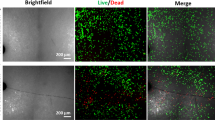Summary
Previous studies of Alcian blue-induced birefringence in adult avian cortical bone showed that a short period of intermittent loading rapidly produces an increased level of orientation of proteoglycans within the bone tissue. In the absence of further loading, this persists for over 24 hours. We have proposed that this phenomenon could provide a means for “capturing” the effects of transient strains, and so provide a persistent, constantly updated strain-related influence on osteocyte populations related to the bones' averaged recent strain history, in effect, a “strain memory” in bone tissue. In our present study, we use the Alcian blue-induced birefringence technique to demonstrate that proteoglycan orientation also occurs after intermittent loading of both cortical and cancellous mammalian bonein vivo andin vitro. We also show that the change in birefringence is proportional to the magnitude of the applied strain, and that the reorientation occurs rapidly, reaching a maximal value after only 50 loading cycles. Examination of electron micrographs of bone tissue after staining with cupromeronic blue allows direct visualization and quantification of the change in proteoglycan orientation produced by loading. This shows that intermittent loading is associated with a realignment of the proteoglycan protein cores, bringing them some 5 degrees closer to the direction of collagen fibrils in the bone matrix.
Similar content being viewed by others
References
Rubin CT, Lanyon LE (1984) Regulation of bone formation by applied dynamic loads. J Bone Joint Surg 66A:397–402
Rubin CT, Lanyon LE (1985) Regulation of bone mass by mechanical strain magnitude. Calcif Tiss Int 37:411–417
Skerry TM, Bitensky L, Chayen J, Lanyon LE (1988) Loading related reorientation of bone proteoglycans, a cue for the control of bone remodelling? J Orthop Res 6:547–551
Johnstone JJ (1979) The routine sectioning of undecalcified bone for cytochemical studies. Histochem J 11:359–365
Scott JE, Dorling J (1965) Differential staining of acid glycosaminoglycans by alcian blue in salt solutions. Histochemie 5:211–233
Scott JE, Kyffin TW (1978) Demineralisation in organic solvents by alkylammonium salts of ethyelenediaminetetraacetic acid. Biochem J 169:697–701
Scott JE, Burton S (1984) Selective demineralisation of hard tissues in organic solvents: retention or extraction of proteoglycans. J Microsc 134(3):291–297
Scott JE (1975) Interactions of phosphotungstate with biological polymers. Acta Histochemica, Suppl.-Bd. XV,5: 213–219
Scott JE (1980) Collagen-proteoglycan interactions. Biochemistry 187:887–891
Kinne RW, Fisher LW (1987) Keratan sulfate proteoglycan in rabbit compact bone is bone sialoprotein II. J Biol Chem 262:206–211
Scott JE (1985) Proteoglycan histochemistry a valuable tool for connective tissue biochemists.Collagen Res Rel 5:541–575
Ferris BD, Klenerman L, Dodds RA, Bitensky L, Chayen J (1987) Altered organisation of non collagenous bone matrix in osteoporosis. Bone 8:285–288
Culp LA, Laterra J, Lark MW, Beyth RJ, Tobey ST (1986) Heparan sulphate proteoglycan as a mediator of some adhesive responses and cytoskeletal re-organisation of cells on fibronectin matrices: independent versus co-operative functions. In: Evered D, Whelan J (eds) Functions of the proteoglycans. CIBA Foundation Symposium 124, John Wiley & Sons. Chichester, England, 1986
Rapraeger A, Jalkenen M, Bernfield M (1986) Cell surface proteoglycan associated with the cytoskeleton at the basolateral surface of mouse mammary epithelial cells. J Cell Biology 103:2683–2696
Hook M, Woods A, Johansson S, Kjellen L, Couchman JR (1986) Functions of the proteoglycans at the cell surface. In: Functions of the proteoglycans. John Wiley & Sons, Chichester, England
Author information
Authors and Affiliations
Rights and permissions
About this article
Cite this article
Skerry, T.M., Suswillo, R., El Haj, A.J. et al. Load-induced proteoglycan orientation in bone tissuein vivo andin vitro . Calcif Tissue Int 46, 318–326 (1990). https://doi.org/10.1007/BF02563823
Received:
Revised:
Issue Date:
DOI: https://doi.org/10.1007/BF02563823




